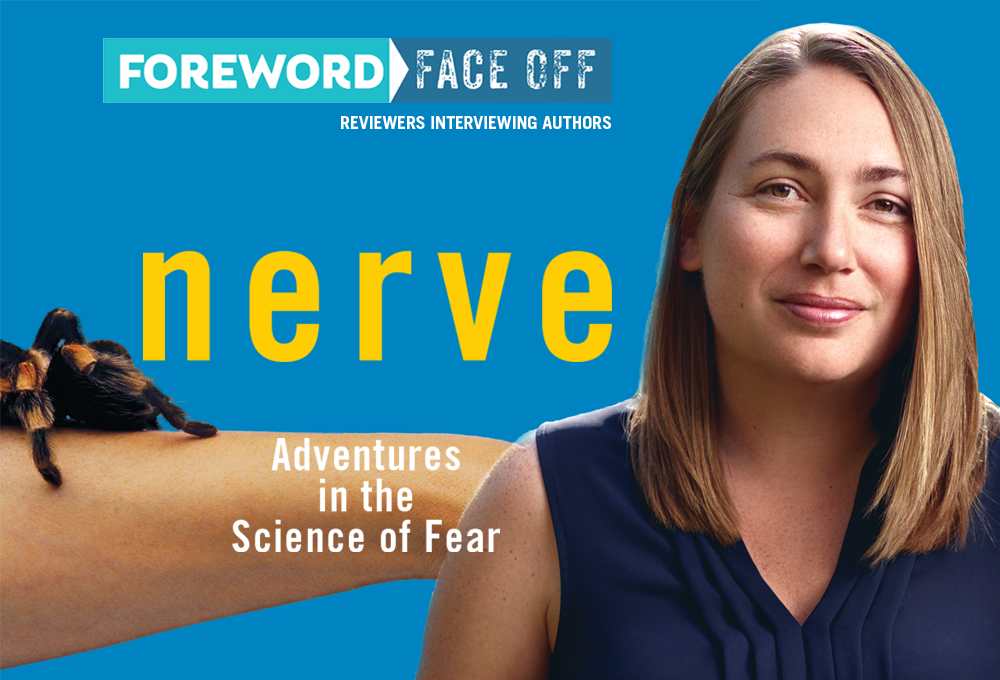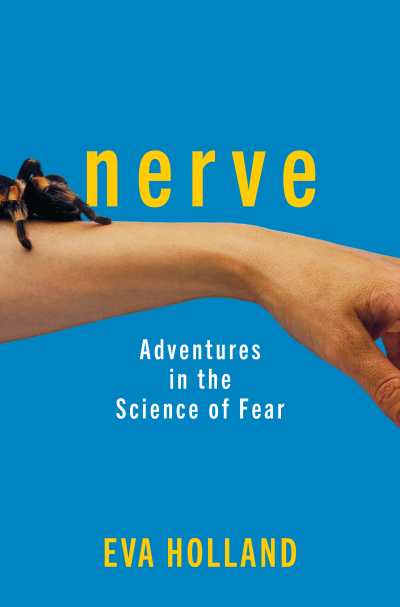Nerve: Adventures in the Science of Fear Interview, April 30, 2020

Reviewer Matt Sutherland Interviews Eva Holland, Author of Nerve: Adventures in the Science of Fear
No doubt, you’ve been hearing a lot of quotes apropos of COVID-19 anxiety, including FDR’s classic, “the only thing we have to fear is fear itself.” Aside from its wonderful word play, we’ve always admired that particular quote because it points to a puzzling truth: just the idea of fear can be debilitating.
Of course, there are evolutionary reasons humans developed a fight-or-flight fear response, what with sabertooth tigers afoot, but the actual physical sensation of fear—shortness of breath, quickening pulse—isn’t all that helpful. We’d be much better off to stay levelheaded as we decide how to deal with a threat. And now, in the twenty-first century, a great many of our fears—spiders, mice, heights—aren’t fearsome; in fact, they’re downright silly. There’s no doubt, fear plays games with us. A fearful Eva Holland set out to understand why.

The author of Nerve: Adventures in the Science of Fear—a title that hints at her droll suspicion that fear too often cries wolf—Eva has long been terrified of heights and the thought of losing her mother. Her book documents the various meds and therapy she experimented with in an effort to get her life back. In his review for the May/June issue of Foreword, Matt Sutherland said Eva’s “demon-chasing journey is an inspiration,” and with the help of The Experiment, we put reviewer and author together for a lively conversation.
Matt, let ’er rip.
First of all, what is fear? We all understand the fight-or-flight response, but why did we evolve to fear so many things (certain phobias) that aren’t all that dangerous, e.g., mice, spiders, speaking in front of crowds, and, in your case, fear of losing your mother? It seems that what we physically feel as fear is a much larger can of worms, and can at times be brought on by grief, extreme anxiety, confusion, sense of mortality, and other things. Can you set some ground rules for us?
My favorite catch-all definition of fear, one that I came across in my research, came from a nineteenth-century psychologist, G. Stanley Hall. He called fear “the anticipation of pain,” and that seemed really apt to me, encompassing a lot of fear’s different permutations.
That said, fear does come in all sorts of different flavors. In the book, I try to parse the distinctions between fear and anxiety (real, but tricky!) and between categories of fear like phobias (over-the-top reactions to specific, often harmless, triggers), trauma (let’s call it the anticipation of pain based on a memory of pain), and the fear of loss and emotional hurt that we might call dread.
Ultimately, we evolved to feel fear because it’s a survival mechanism—it lets us identify and react to threats to our well-being, and that’s really important. But it can become aberrant, or maladaptive, to use the terminology of some of the scientists I spoke to and read about, and that’s when it starts to lead us astray. While I set out to “conquer” my fears, ultimately what I’m trying to do in the book is to figure out when to listen to my fear, and when to try to tune it out.
Which comes first, our brains raising the fear alarm or the fright, tingling skin, cold sweat, and muscle tension that our bodies conjure up?
This seems counterintuitive at first, but the physical sensations in our body come first, and the feeling of fear—the conscious realization: “I am afraid”—comes second. What happens, as best we understand it, is this: the sensory nerves in our body—responsible not only for sight, smell, taste, and hearing, but also for variations on touch: heat, pressure, and so on—carry information to our brains about the world that surrounds us. If some of that information includes a potential threat to our safety, then our fear response is triggered: our chest tightens and breath shortens, pulse accelerates, pupils dilate, and so on. The information about those physical responses is then carried back to our brain, and our conscious mind says: Aha! I am afraid.
That seemed really strange to me at first, until I spent some time thinking about how I felt in moments of real fear. So much of it is experienced as a physical sensation first, and a conscious emotion second!
Certain individuals seem to be more susceptible to chronic, debilitating fear, no matter the source. Why is there such a difference between people?
That’s one question that scientists still don’t have a firm answer for—more like a menu of possible explanations. There is a possible genetic influence, certainly—phobias and anxiety disorders do seem to run in families. There’s also evidence that children with what’s known as an “inhibited” personality are more likely to grow up to be phobic or anxious. (On the flip side, people who are drawn to risk and danger, known as high-sensation seekers, seem to be less likely to experience these kinds of feelings.) And, of course, some fears still seem to be traceable to specific childhood experiences. But it’s hard to say, for any given individual, which factor is the determining one. And there may be no one answer. For my fear of heights, for instance, I could check all three of those boxes.
For people who worry they’re fearful to an unhealthy extent, will you offer a sense of perspective? What is too much fear? How do we recognize whether or not we’re controlled by our fears and that it’s time to do something about it?
It’s a hard thing to define, and to some extent we all have to set our own limits and say: “This has gone too far for me,” or, “This is no longer an acceptable level of fear.” But for me, it was about my fears impairing me from doing things that were important to me both personally and professionally. They made my world smaller to a point I could no longer accept, and remaining restricted in those ways seemed worse to me than trying to put in the time, money, and pain involved in trying to face them down.
Everyone’s calculus on that will be different. But I’ll give an example from the book: If you have, say, a fear of mice, but you only react when you actually see a mouse, and your home is mouse-free, then I’d say that’s something most of us could live with. If, however, your fear of mice leaves you anxious about the potential presence of mice all the time, like a woman I wrote about, if you can’t sleep at night for fear of mice, for instance, even though your home is mouse-free, then that is probably too much fear, and it’s time to take some action. It’s about the extent to which our fears bleed into and take over our lives.
By rock climbing and jumping out of a plane, you took a “screw it” approach and tried to face your fear head-on. Can you talk about that specifically? Does it work for some people? What role should courage play in the face of fear?
Ha, well, I don’t think the “screw it” approach is likely to be all that effective for many people! I don’t think my skydive did me any harm—it didn’t set me back—but it definitely did not help any. That said, a more controlled exposure is a really important part of a lot of treatments for excessive or aberrant fear, and it’s really hard to tackle these fears without some degree of confrontation. My rock climbing, although it sounds dramatic, ultimately was a more gradual and controlled form of exposure, and that kind of classic “exposure therapy” approach can be helpful for a lot of people (though certainly not all, unfortunately).
Exposure and avoidance are sort of like opposite sides of a coin, I guess. Exposure, too much of it or in the wrong way, can be harmful, and avoidance can seem like the safe option. But avoidance can become harmful too, like in my mouse example, above. So it’s tricky. I never felt brave when I was doing all this stuff, but I suppose confronting our fears is a form of courage, even if it can make us feel more afraid and vulnerable than ever to do so.
Let’s talk about some of the new research and therapies you write about in Nerve. What do you find especially exciting? Is Eye Movement Desensitization Reprocessing something that can be practiced at home alone?
The experimental drug/exposure treatment I did in Amsterdam for my fear of heights was very exciting! The results were dramatic and nearly instantaneous, so that was very cool. I was also blown away by the results I had from the eye movement desensitization reprocessing I underwent for the trauma resulting from a series of car accidents. It was such a strange experience—I was always one to be, I guess, gently skeptical about some of the mind-body connection stuff you hear about, but it really was such a visceral thing. I felt something clicking into place in my body when the issue was resolved. I’ll be thinking about that for a long time.
Unfortunately, EMDR does require working with a trained therapist, although one of its advantages is that it generally requires very few sessions, which saves on costs—as few as one session of the actual eye-movement therapy, though I did two of those sessions, plus an intake session and a preparatory session. There is a less dramatic technique known as tapping that people can do on their own at home, though, which may bring some relief. There are YouTube videos that explain it, or the resource that was recommended to me is a book by Laurel Parnell, also a leading EMDR therapist, called Tapping In.
What’s next for you and your writing career? Are you currently working on something, and can you talk about it?
I’m looking forward to getting back into magazine work, which I had mostly put on hold while I was working on Nerve. And as far as books go, I can’t get into specifics right now, but I will say that I am working on figuring out how to research a second book under pandemic travel restrictions!.
Matt Sutherland
